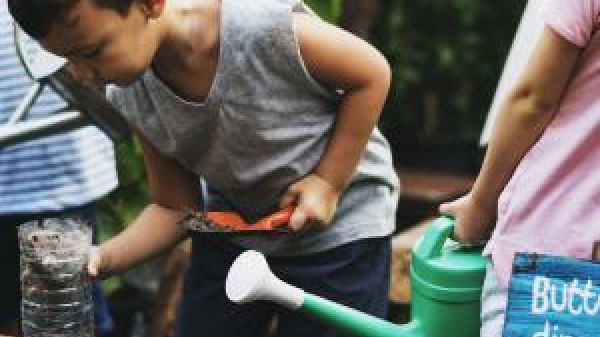Early Childhood EE

A positive and caring attitude toward the environment is a critical component of environmental literacy, and research shows that most attitudes are formed early in life. Providing young children with frequent opportunities to experience the beauty and wonder of the natural world, develop positive emotional connections with their immediate surroundings, and care for plants and animals establishes a necessary foundation for learning about environmental issues and taking appropriate action later in life. In addition, a growing body of evidence documents the many benefits that time spent playing and learning in nature has on children’s healthy development.
The following resources will inspire and guide early childhood environmental education professionals in nature centers, museums, preschools, daycares, colleges, universities, and other settings as they help young children connect with nature and care for the environment.
If early childhood environmental education had a patron saint, it would be Rachel Carson. Better known for her research and writings on the dangers of pesticides, Carson’s ideas on introducing young children to the joys and wonder of nature have inspired many environmental educators and reassured them that, for children and caregivers alike, “it is not half so important to know as to feel.” Written in an almost lyrical tone, this short book will nourish and remind you why your work matters.
Guidelines: Action orientation, Depth, Emphasis on skills building, Fairness and accuracy, Instructional soundness, Usability
Based on almost three decades of work in early childhood environmental education, the third edition of Ruth Wilson’s book provides a highly accessible overview of the philosophy, research, and best practices in nature-based play and learning. If your program’s goal is to promote the healthy development of young children along with an ethic of caring for the environment, there are few other resources that present the why, what, and how in a better researched and better written way.
Guidelines: Action orientation, Depth, Emphasis on skills building, Fairness and accuracy, Instructional soundness, Usability
So many people have been inspired by Richard Louv's Last Child in the Woods (which is another a key resource in early childhood environmental education!) for a variety of reasons. I think one reason the book has sparked so much interest is its extensive use of research to back up its central argument that children are suffering from a lack of nature. The eeRESEARCH database is a collaboration between NAAEE and the Children & Nature Network, an organization launched because of Last Child in the Woods. The database puts all of that research, and much more, at your fingertips so you can use it to make the case for early childhood environmental education.
Guidelines: Action orientation, Depth, Emphasis on skills building, Fairness and accuracy, Instructional soundness, Usability
Published by NAAEE, this is the only peer-reviewed journal dedicated to early childhood environmental education. And because it's available for free online, it puts current research in any educator's hands. Although it is an academic journal, the articles tend to be easy for anyone to understand and use--no PhD required!
Guidelines: Action orientation, Depth, Emphasis on skills building, Fairness and accuracy, Instructional soundness, Usability
As nature preschools explode in popularity, many people are wondering how they can start a nature preschool of their own or bring one to their community. Nature preschool veteran Rachel Larimore is a consultant who helps people with everything from clarifying their philosophy to developing their business plan, and this book puts her knowledge into your hands. If you're thinking that a nature preschool might be your path to offering early childhood environmental education, this is a great resource to help give you a road map to get started.
Guidelines: Action orientation, Depth, Emphasis on skills building, Fairness and accuracy, Instructional soundness, Usability
Really any title from David Sobel is great reading for anyone interested in early childhood environmental education (he has inspired so many educators over the years), but I like this one because I think it's really at the heart of what environmental educators working with people of any age are trying to do: connect people to the places where they live so they can enjoy and protect them for a lifetime.
Guidelines: Action orientation, Depth, Emphasis on skills building, Fairness and accuracy, Instructional soundness, Usability
This book is a hidden gem! Written by early childhood education veteran Marcie Oltman, it's a great introduction to developmentally appropriate practice in early childhood environmental education, which is a major theme of the Guidelines for Excellence. And as a bonus, it's available for free!
Guidelines: Action orientation, Depth, Emphasis on skills building, Fairness and accuracy, Instructional soundness, Usability

